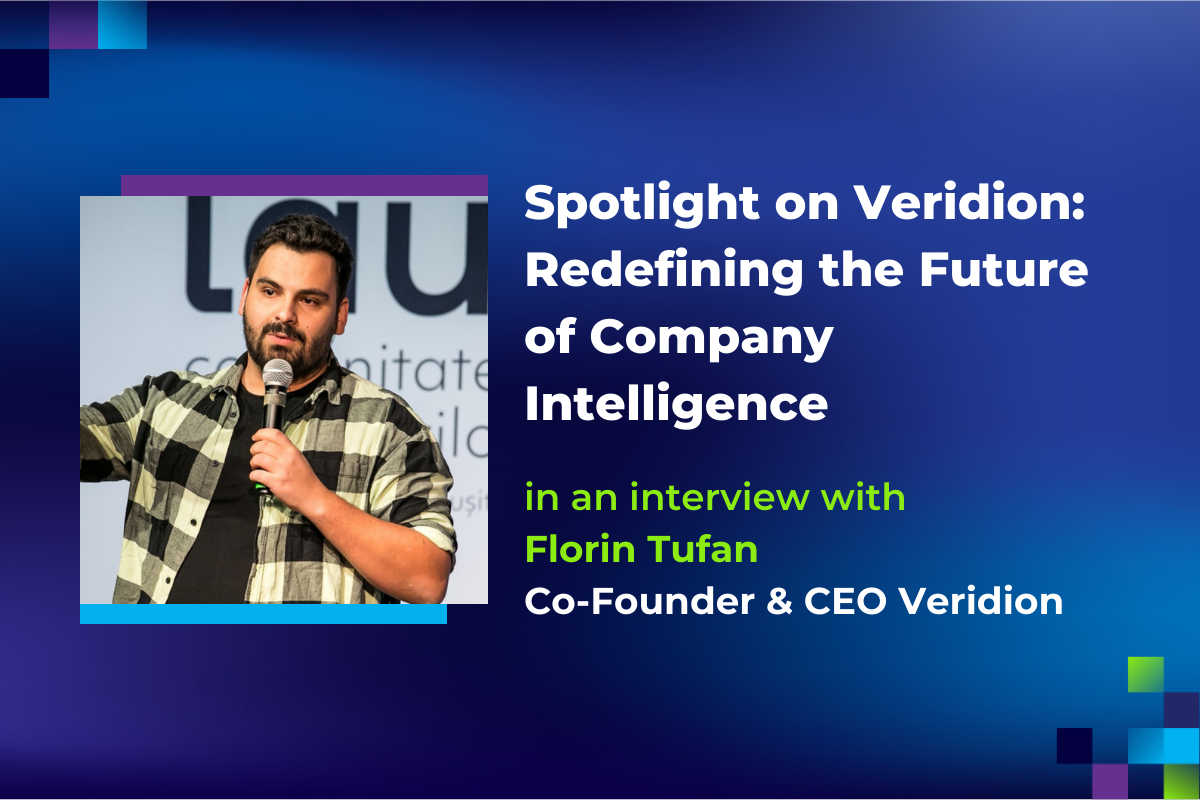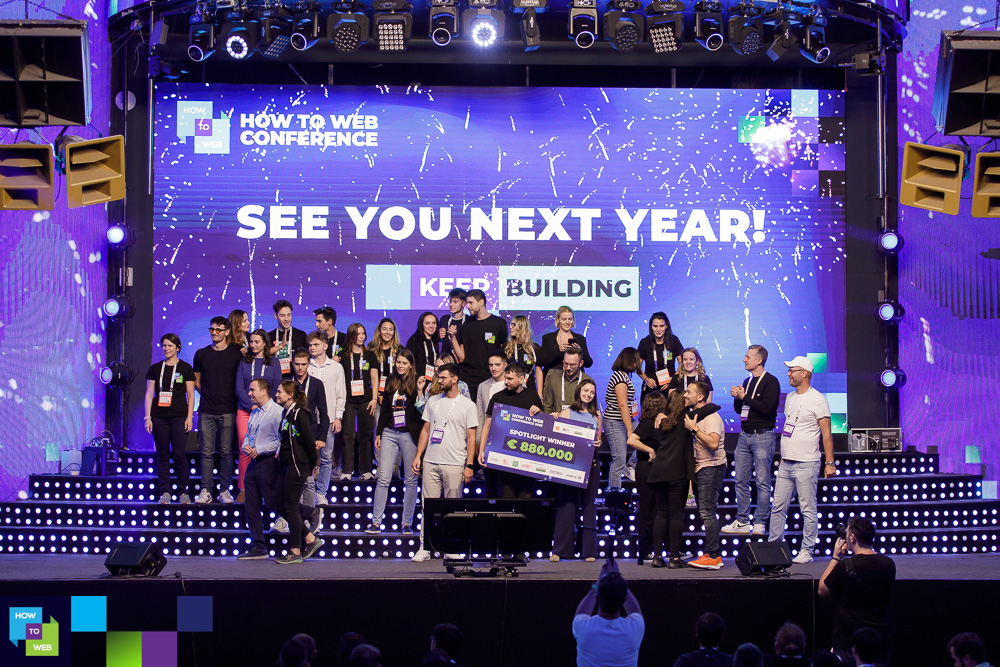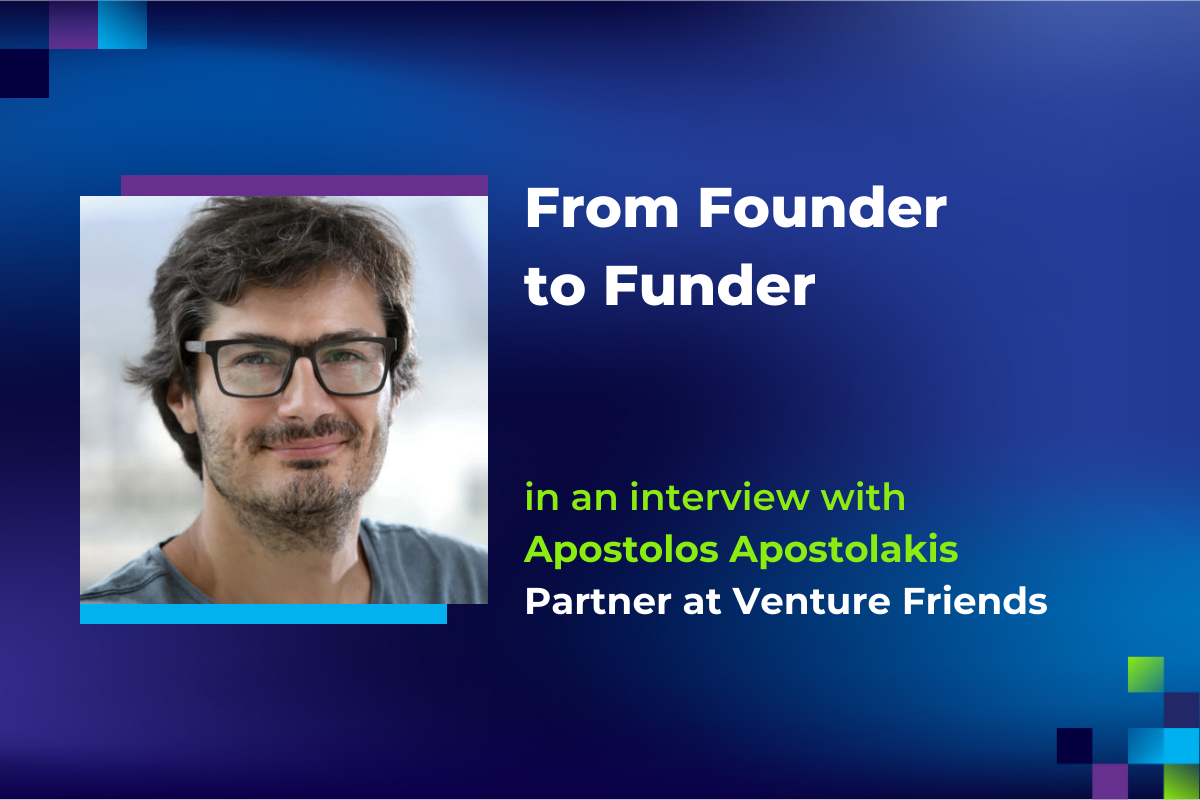27 September, 2023

We are lucky to witness innovation being born with so many avant-garde startups that go through our Spotlight program and competition. Veridion is one of our Spotlight Alumni, and also one of the startups that encompasses the very essence of what we call #builder at How to Web. Veridion is the startup that started as a project promising to address the market’s need to understand what companies communicate on the internet through AI.
This year, Veridion has raised $6M in seed round, an achievement that they view more as a result. In addition to their financial growth, they are in the midst of expanding their team and recruiting solution-oriented and technology-savvy individuals.
Our partners, BRD – Groupe Société Générale, have initiated a special project to support Romanian startups and offer them a platform where they can tell their stories and reach a wider audience. Among their Startup Chronicles, which features a selection of our Spotlight Alumni, you can find Veridion with their very interesting journey.
Discover more in the following interview with Florian Tufan, the Co-Founder and CEO of Veridion:
What’s your startup’s story and what customer pain points are you solving?
We started Veridion as a side project so it was never meant to be a startup, it sort of happened this way. Based on the needs from my previous jobs and my career in sales, marketing, and market research, I was aware of this limitation in the market about finding the right company information and the right information about markets.
What challenges did you have to face in the startup’s first year?
In our first year, I think it’s really uncommon compared to other startups. Our main priority was to actually validate the technology and the fact that it was possible what we were trying to achieve. The reason for this is that we were familiar with some machine learning and natural language processing technologies. But in our case, we needed to apply them on a huge scale. We’re talking about hundreds of billions of web pages that we needed to process with machine learning. We weren’t aware of the trade-off between the quality of the output of the AI or machine learning model versus the need for scale, processing power, and speed. If it was actually possible to have a good output and how we’re going to get there while still managing to crunch a lot of data.
So our first year was mostly about: Can we do it? Can this be done? Is this the right time?
Because we were also aware of some startups a few years before us that received funding from Andreessen Horowitz and others and they failed technically. In their postmortem they declared that the technology just isn’t there, it’s not possible. So we wanted to see if this new, back then, technology with transformers could actually overcome the challenges that others faced before us.
So our first year was mostly focused on proving it and while doing that we took some clients as clients for services. So we worked as an agency where we said that we were going to provide you the data you need in exchange for a custom project for your startup. We were addressing YC startups at every batch and our main goal was to while serving this client proving that the technology will work.
What were the most important milestones between the first moment and this moment?
It’s hard to say which one was the most important because they’re all important in their time and in their way. The first one was getting the first client to pay for it. A sort of assurance that there’s a five-figure need behind what we’re selling. We didn’t know what the business model would be and didn’t have automated technology back then. But it was really important to convince someone as a Romanian founder, a small team, to pay us five figures without questioning, because it meant that the service was valuable enough that we were going to be able to turn it into a business if it worked.
Then, when it started working we stopped selling services which I think is also extremely important because we wanted to build an automated technology and have it available for self-service to clients.
So we took a six-month break from selling any sort of services, just focused on automating the technology and the moment I remember, it was this day, right before Christmas in 2019, we had our first “go live” where the technology was automated, and it was doing things without us having to fix things through all the time, and then we showed it to VC. They didn’t like it at all.
But then a few months later, we had another milestone which was raising the first round, the €200k pre-seed round from Gapminder and then about another six months later, we got our first enterprise client. That was another massive milestone because we didn’t know anything about enterprise sales, and navigating through that process, and spending two months with a lawyer, was completely new to us, but it marked the rest of the history of the startup. And I would say more recently, passing the famous 1 million euro MRR was also an extremely powerful moment.
Can you tell us more about this year’s $6M seed round?
I don’t look at this as a milestone because I think the milestone is actually reaching the right level of revenue and the right number of clients, and the type of clients we have, and the technology so the raising came as a consequence of that.
Where does How to Web’s Spotlight program and competition fit on your growth map?
Spotlight was at the very beginning before we showed it to the first VC before we had the technology working and it was extremely important, especially for founders like us who don’t really like to get out of the office.
So we spent very little time communicating with the ecosystem, getting any sort of advice or socializing our product with VCs. So what Spotlight did for us was that it compressed all that effort that it takes to speak to tens of people into just one day. And for us, it was perfect because we got basically all the benefits of somebody who focused on networking a lot, but we didn’t have to leave the office for more than one day at a time.
How was the experience of raising the first investment round back in 2019? What challenges did you have?
Raising the first round was a six-month journey. It started with Spotlight, where we met, I think, about 15 VCs during the program. It went really bad because we didn’t know how to interact with them, we didn’t even really understand the business model, what the pitch or what the focus was on, and what kind of questions they expected.
Meeting so many VCs in a short time was a brutal experience for us, it helped us a lot afterwards. But it also taught us that we’re not nearly ready to raise. So a few months later, actually with the How to Web team, we went to Berlin to TechCrunch Disrupt. And we also started rehearsing our pitch and trying to do a better version of it. Again it was bad. But it gave us the opportunity to iterate on how we pitched and how we presented to the VCs. We didn’t have any chance of raising. But then another couple of months later we started actually nailing the pitch and doing it every day. And it started working, people started to book second and third meetings with us. Started to show interest, and started to look at financial models which weren’t making much revenue. So we didn’t have one, so we had to build one in one night.
We started with the bias of raising from Central Europe because we said we’re a deep tech startup, we’re going to need a lot of money, we only have technology working, we don’t have much commercial traction. So we started with the bias that nobody from Eastern Europe would invest in us because we’re just too different from what we thought VCs from Eastern Europe expect from us.
It turned out it was the exact other way around. We got a lot higher expectations on the commercial side and a lot less passion for technology from Central and Western Europe. And a lot of interest in DeepTech startups trying to do something very ambitious, trying to succeed where others failed. And we ended up raising from Gapminder, which turned out to be a very good choice. Because of our level of inexperience, as first-time founders, it helped to build a very close relationship that started geographically with the VC and to sort of go through the initial lessons together.
How was the deep tech landscape back when you started? And how is it now?
When we first raised our round, VCs were like not so excited anymore about AI because they were saying, okay, AI has been around for a while. Nothing has really changed. The technology has gotten maybe incrementally better. There’s no real revolution happening in space. And in truth to be told, we didn’t have the confidence to contradict them, although we felt very different about the commercial opportunity of it rather than the technology side. But in fact, history shows that there was a transformation happening, a massive revolution brought by Transformers that we now see as its combination with chat GPT and all the other technologies that we’re seeing today. But it was so hard to convey it back then or to explain it or to be sure that, okay, this is the revolution because it’s very hard. You just know how well it works. It’s very hard to see a revolution when you’re very near to it.
What happened now is that everybody realized — so there’s a lot more support for building very ambitious projects, crunching a lot of data using AI and NLP and Transformers at a super high scale. which back when we raised our first round, people were looking at it as a sort of maybe even risk of running too high of server costs for having wild expenses, wild crunching of data, and having very little control over the models. Now the entire attitude towards building AI technologies has changed significantly. Maybe they even overestimate it to an extent.
What’s next for you, for your team? Tell us about your future plans.
We focus on two things. We focus on doing more of the same and learning to do it even better. We have a small sales team in North America. We’re growing it, hiring right now, and being able to scale the processes that got us here to a much better extent and build a bigger team to promote the companies and find all the clients that need our services in a short time span.
So right now we are doing what is already working, we work with financial services and consultants, and we need to build a bigger team to be able to capture all the opportunities that are in the market – that is number one.
And number two, we’re focusing on having the name Veridion known by everybody who needs company information, that does market analysis or that does research on how different markets and landscapes are developing. For example, companies that help other companies find the right acquisition target or find the right acquisition target or in the supply chain with large manufacturers that need to find suppliers. We know all these needs happen not just at 500 Fortune companies, but they also happen in smaller companies or even with junior users who need to do some research for a larger marketing strategy, for example.
We’re focusing on building the right tools and making them available for free or for very cheap to build, imagine, a GPT for company information and for interacting with markets that explain what changes in the neighbourhood and how this differs from this place in New York and this in London and what has changed in the past six months. We can ask these questions like what new AI tools have popped up this week and you can interact with it without having any technical expertise or any prior knowledge. It just helps you in your task.
What do you enjoy the most about being a founder and why?
I think privilege trade by being a founder, the one that makes up the for all the hard times is being able to build the team as you find fit, and you find the people that make you proud in your day-to-day work and I think regardless of what your startup does, or what challenges, or what moments in the life of the company you act, I think this makes up for all the bad think.
It is not related to signing the contract, or launching this product – these are all great. But I think having the freedom to build a team as you find fit and look for the personality traits, and sometimes the best reward for me is when we have a few team members that are very junior when they join, and now they are super spectacular professionals in less than 2 years – that makes me proud.
What kind of resources do you need to achieve your next milestone?
We’re looking for passionate people who like to work with a lot of data and like to solve problems, especially in data science, big data and machine learning. It is a lot about having the right mindset for problem-solving and a passion for technology, covering things, and discovering how to come up with solutions. Most of our challenges are things that other people say it is not possible, or have to choose between this or this so in our process we need to find a lot of solutions that should work, or find technologies that should not be like that, but work properly. So what we are looking for is the right passion for solving problems above anything else.
Even at our interviews, we give problems that can be solved on paper because it is about how clear your thinking is, and how committed they are to finding the solutions.
What were the main resources that you needed in the first year for Veridion?
I think most challenges in the life of an early-stage startup are actually just a matter of time. You’ll get there eventually. If your first VC pitch doesn’t work, you just try harder. Iterate on it. And it will eventually work. So I think the biggest challenges that happen in an early-stage startup are actually related to building the right team. So I’d say our top three challenges were actually solved by three key hires. Number one, our Head of Machine Learning joined when he was 22 and he has helped us build radically better NLP, machine learning, and AI since then. Number two, our Head of Data has joined and rebuilt our entire infrastructure from scratch and helped us make a scalable product. And number one, we have a Head of Sales in North America who comes from one of the largest companies in the space and helped us build the right, ultimate strategy.
Veridion’s story serves as a reminder that with hard work, determination, and the right support, even the most ambitious dreams can become a reality.
We look forward to witnessing their continued growth and success in the ever-evolving landscape of technology and AI online research, and until then watch Veridion’s startup story in this short video, here.
1
You may also like
How to Web 2023 brought together over 2,500 international participants, 60 global speakers, and an investment prize of €880,000 for the best Eastern European startup
We are lucky to witness innovation being born with so many avant-garde startups that go through our Spotlight program and competition. Veridion is one of our Spotlight Alumni, and also one of the startups that encompasses the very essence of what we call #builder at How to Web. Veridion is the startup that started as… Read more »
1From Founder to Funder: Apostolos Apostolakis on Building and Backing Startups
We are lucky to witness innovation being born with so many avant-garde startups that go through our Spotlight program and competition. Veridion is one of our Spotlight Alumni, and also one of the startups that encompasses the very essence of what we call #builder at How to Web. Veridion is the startup that started as… Read more »
1


